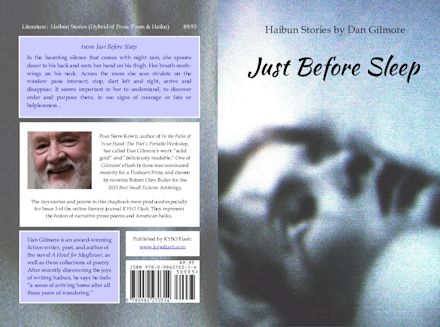|
KYSO Flash ™
Knock-Your-Socks-Off Art and Literature
|
|
|||
“After All These Years of Wandering”by Clare MacQueen
—Front-cover photograph of sleeping woman, by Kema Keur, is reproduced here under Creative Commons License, Attribution-ShareAlike 2.0 Generic: Creative Commons 2.0 Legal Code From the back cover: —Dan Gilmore’s work has been called “solid gold” and “deliciously readable” by poet Steve Kowit, author of In the Palm of Your Hand: The Poet’s Portable Workshop. A year ago in May, I fell in love with a new-to-me form of poetic hybrid, the haibun. How I had managed to overlook it for 30 years since my first creative-writing courses in college amazes me—but better to discover it late than never, as my mother used to say. What exactly is a haibun? Here’s a thimble-size definition of this centuries-old Japanese form, whose purists might agree is distilled to a mere whiff of its true complexity: Haibun are prose poems which include at least one haiku. Sounds simple and easy. But only to the uninitiated. Surprisingly, haibun can be quite a challenge to write well, in part because one must be equally proficient at writing both poetic prose and poetry—and at achieving a subtle balance between the two. The works in Just before Sleep illustrate this concept nicely. As their author Dan Gilmore says, finding that balance was “the toughest and most fun challenge.” Of course, an in-depth discussion of the haibun’s history and complexity is beyond the scope of this introduction. In a walnut-shell then: I understand haibun to exist on a continuum, from conventional to experimental. The conventional are written in a journalistic or “factional” style, and because the prose reports on a single moment, it’s expected to be rooted in physical reality. The haiku typically includes a seasonal reference, and the best ones often derive their power from juxtaposition. Usually, only one haiku appears, at the end of the haibun, though its role is more than mere attachment. On the contrary, the haiku may offer an epiphany or revelation which the prose points to, often obliquely. On the other hand, in unconventional haibun such as haibun stories, any number of haiku may appear anywhere in the text. Their role typically expands and deepens the prose. Not surprisingly, experimental haibun may dispense with rules of the traditional form—especially when written by practitioners working in English who may happily ignore the syllabic and line-length restrictions of traditional haiku. Plus, although they may include the factional as well, haibun stories lean in various degrees toward imagined or embellished realities by employing one or more elements of fiction, such as dialogue, characterization, and plot, to tell the Truth of an experience. Just before Sleep, a chapbook of extraordinary haibun of the “ordinary sacred,” is the remarkable result of an experiment, i.e., Dan Gilmore’s enthusiastic answer to a challenge for writers of prose poems and micro-fictions in February: “Try your hand at haibun stories!” And then, submit them to KYSO Flash for possible publication. Gilmore was the first to send us works on the first of March, when the reading period for Issue 3 opened. “A Smart Fly,” “Just before Sleep,” and “Seagulls” impressed us so much that we invited him to submit others as well. Which he did right away, to my delight. I was already a fan of his writing, having read and published a few of his prose poems and flash fictions. The idea soon came to me to publish a chapbook of Gilmore’s haibun stories. I was thrilled when he agreed to give it a go. And over the course of six weeks, we accepted for publication 23 of the pieces he contributed, including 14 new works. I think it’s clear that he truly enjoys working with haibun, though he says, “I’m too old to do anything that feels remotely like work. It’s all play, except when I have to clean my desk [or] walk on the treadmill. I love writing haibun and will continue to do so until...” In another email, he wrote: “These haibun started out as experiments. I’d never heard of them. But at your prompting I dove in and they seemed to fit my temperament. I’ve been writing for about 20 years. I can honestly say that this is the most fun I’ve ever had....I’m thinking up haiku in the middle of the night....They pop up like prairie dogs but on their own schedule. I seem to have no control over when they decide to show themselves....” [See also Author Commentaries on Haibun Stories.] His response to our call for haibun stories far exceeded anything I had expected or imagined. Admittedly, my original goal was selfish: to inspire flash writers to try this “new” and intriguing hybrid form in hopes they too would fall in love with it, and then write lots of haibun stories for me to read! And now, I cannot describe just how grateful and honored I feel that writing haibun has brought Dan “the joy of discovering a form that seems to fit me, and a sense of arriving home after all these years of wandering.” Dan Gilmore’s poems are filled with wisdom, deeply touching, eminently readable, and often humorous. They mirror our own truths as well, and help bring us home to ourselves. A Smart Fly begins this chapbook in KYSO Flash... The print version of Just Before Sleep is available at Amazon. Clare MacQueenIssue 3, Spring 2015
 Clare MacQueen (in 2006) Bellevue Botanical Gardens Photo by Gary Gibbons is Editor-in-Chief and webmaster for KYSO Flash, and has also served as copy editor and webmaster for Serving House Journal since its creation five years ago. Her short fiction and essays have appeared in Firstdraft, Bricolage, and Serving House Journal, as well as the anthologies, Best New Writing 2007 and Winter Tales II: Women on the Art of Aging. She won an Eric Hoffer Best New Writing Editor’s Choice Award for nonfiction and was nominated twice for a Pushcart Prize in nonfiction. Ms. MacQueen and her husband Gary Gibbons have designed and built custom websites as a team for ten years. They also share avid interests in sci-fi movies, flower gardens, and urban beekeeping. |
|
Site contains text, proprietary computer code, |
|
| ⚡ Many thanks for taking time to report broken links to: KYSOWebmaster [at] gmail [dot] com ⚡ | |
